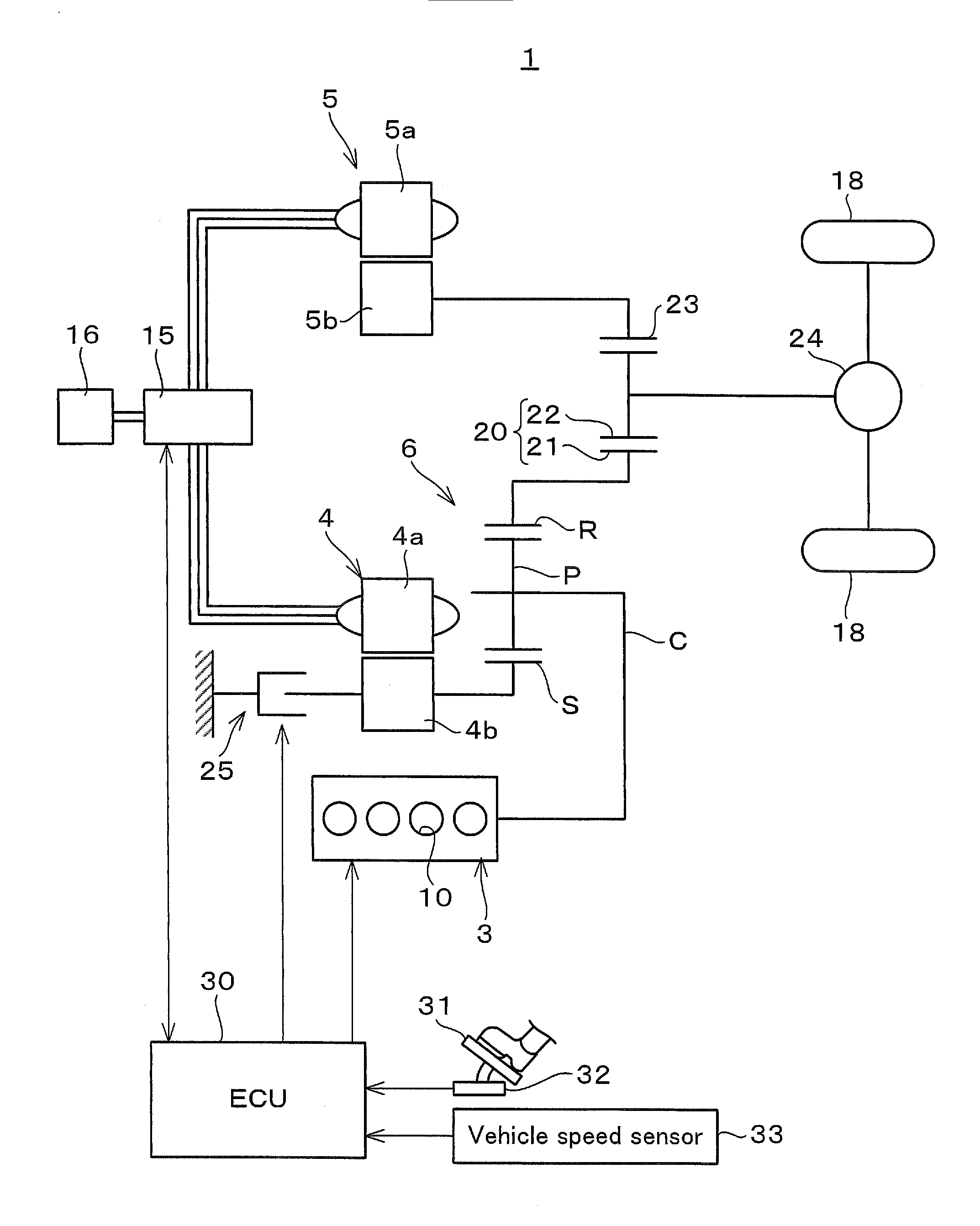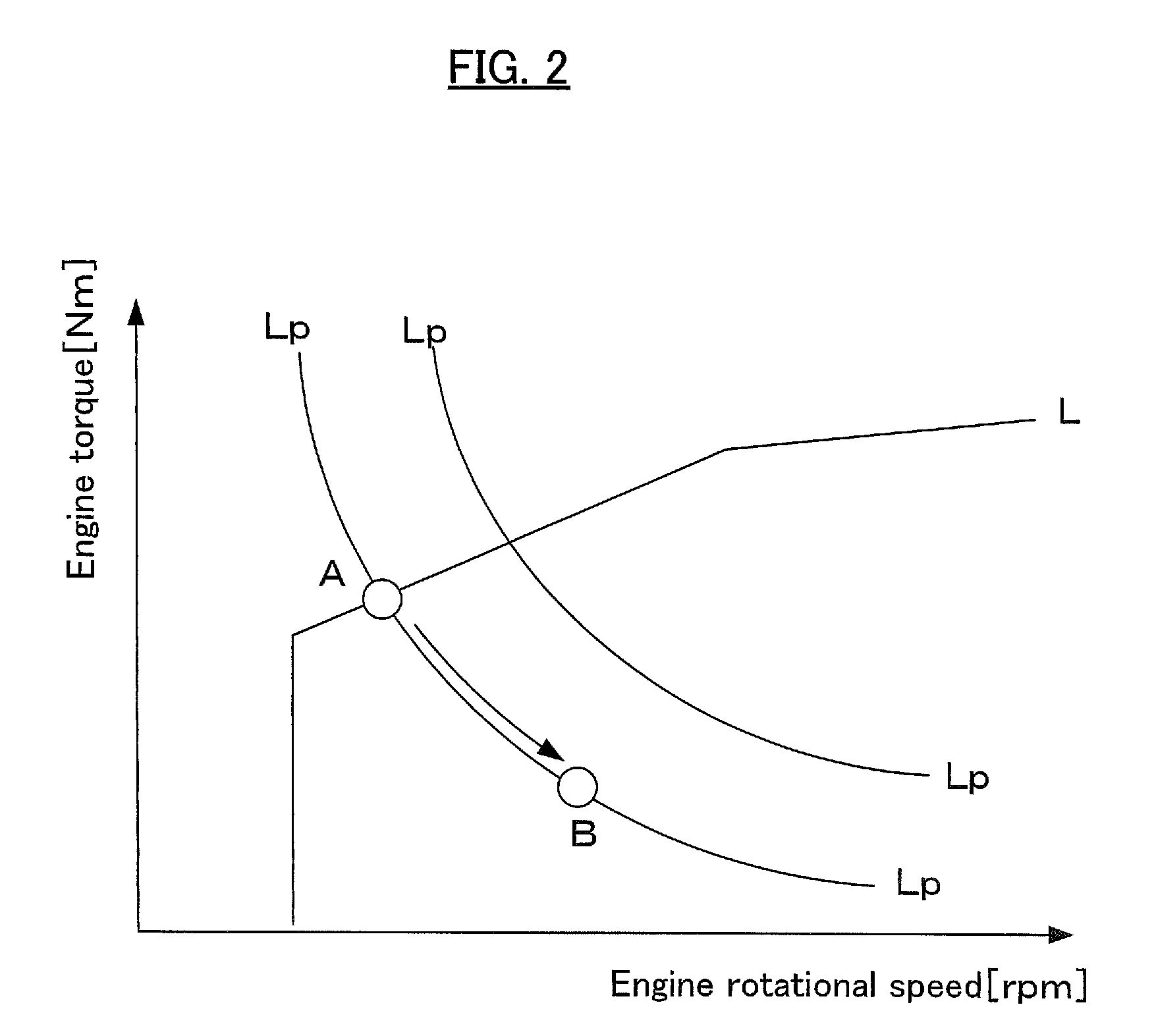Control device for hybrid vehicle
a control device and hybrid technology, applied in the direction of electric propulsion mounting, electric control, machines/engines, etc., can solve the problems of generating gear rattle noise, and achieve the effect of suppressing gear rattle noise, small torque output, and greater change during all-cylinder operation
- Summary
- Abstract
- Description
- Claims
- Application Information
AI Technical Summary
Benefits of technology
Problems solved by technology
Method used
Image
Examples
embodiment # 1
Embodiment #1
[0024]As shown in FIG. 1, a vehicle 1 is built as a hybrid vehicle in which a plurality of power sources are combined. The vehicle 1 comprises an engine 3 and two motor-generators 4 and 5 that serve as power sources for propulsion. The engine 3 is built as an internal combustion engine of the four cylinder in-line type having four cylinders 10. The engine 3 is able to perform all-cylinder operation in which all of the four cylinders 10 operate, and also partial cylinder operation in which two of the four cylinders 10 are deactivated and the remaining two operate.
[0025]The engine 3 and the first motor-generator 4 are linked to a power split mechanism 6 that serves as a differential mechanism. The first motor-generator 4 has a stator 4a and a rotor 4b. The first motor-generator 4 both functions as a generator that receives mechanical power from the engine 3 after distribution by the power split mechanism 6 and generates electricity, and also functions as an electric motor...
embodiment # 2
Embodiment #2
[0036]The second embodiment is distinguished by the feature that change of the operating point of the engine 3 is implemented by operation of the motor locking mechanism 25. In other words, if the motor torque has entered the operating point changeover range R1 or R2, then the ECU 30 operates the motor locking mechanism 25 and prevents rotation of the first motor-generator 4, so that the power split mechanism 6 is changed over from the differential state to the non-differential state. Due to this, none of the torque of the engine 3 is distributed to the first motor-generator 4, and this torque is entirely transmitted to the output gear train 20. In other words, by changing over the power split mechanism 6 from the differential state to the non-differential state, a one-to-one correspondence relationship is established between the rotational speed of the engine 3 and the vehicle speed. Due to this, as shown by the arrow in FIG. 6, the operating point upon the normal line...
embodiment # 3
Embodiment #3
[0038]The third embodiment is distinguished by the feature that the method of changing over the operating point of the engine 3 is changed over between the case of all-cylinder operation and the case of partial cylinder operation. In partial cylinder operation, the torque that can be outputted is smaller as compared with all-cylinder operation, since some of the cylinders are deactivated. In other words, as shown in FIGS. 8A and 8B, the normal line Lb during partial cylinder operation is positioned more towards the low torque side than the normal line La during all-cylinder operation. Since, as described above, the normal lines La and Lb are set so that the fuel consumption of the engine 3 becomes optimum, accordingly the normal lines La and Lb are set so as to pass through the centers of the contour lines Ha and Hb for the thermal efficiency of the engine 3, in other words are set so as to pass through the positions where the thermal efficiency of the engine 3 is at it...
PUM
 Login to View More
Login to View More Abstract
Description
Claims
Application Information
 Login to View More
Login to View More - R&D
- Intellectual Property
- Life Sciences
- Materials
- Tech Scout
- Unparalleled Data Quality
- Higher Quality Content
- 60% Fewer Hallucinations
Browse by: Latest US Patents, China's latest patents, Technical Efficacy Thesaurus, Application Domain, Technology Topic, Popular Technical Reports.
© 2025 PatSnap. All rights reserved.Legal|Privacy policy|Modern Slavery Act Transparency Statement|Sitemap|About US| Contact US: help@patsnap.com



